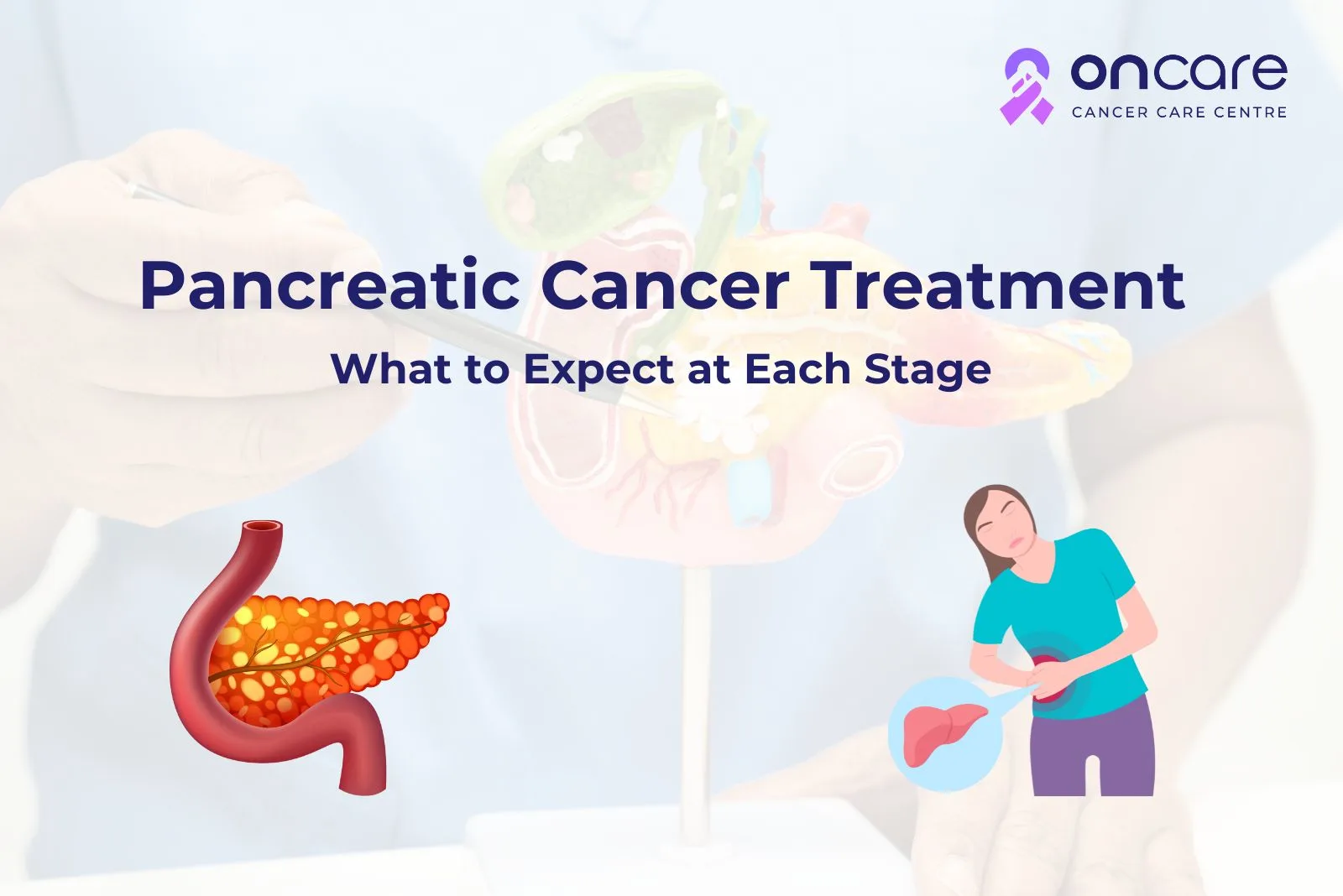Table of Contents
Pancreatic Cancer Treatment: What to Expect at Each Stage

Pancreatic cancer is one of the leading causes of cancer deaths across the globe. According to WHO, pancreatic cancer is the 12th most common cancer in the world, with more than 500,000 people estimated to have been diagnosed with this cancer in 2022. This is the sixth most common cause of cancer deaths, claiming the lives of 470,000 people in 2022. If you or any loved ones are diagnosed with pancreatic cancer, then read further! We’ll explore more into pancreatic cancer stages and its treatment options. Pancreatic cancer is one of the deadliest cancers with the least chances of recovery!
In this article, we’ll explore more about pancreatic cancer, what causes pancreatic cancer, symptoms, stages, and treatments.
What is Pancreatic cancer?
Pancreatic cancer is a type of cancer that begins with the growth of cells in the body part of the pancreas. The pancreas is located behind the lower part of the stomach. This produces enzymes that help digest food and hormones that help manage and regulate blood sugar.
The most common type of cancer in the pancreas is known as pancreatic ductal adenocarcinoma. In this type of cancer, it starts in the cells that line the ducts that carry digestive enzymes out of the pancreas.
Cancer in the pancreas is rarely detected in its early stages. When this cancer is detected in the early stages, the chances of recovery are the highest. However, one of the worst parts of this cancer is that it won’t show any symptoms until it has spread into other body parts.
Symptoms and causes
The symptoms of pancreatic cancer are not shown in the early stages. The symptoms may include:
- Belly pain that spread to the sides of the stomach
- Tiredness or weakness
- Weight loss
- Dark-colored urine
- Itching or rashes
- Loss of appetite
- Jaundice
- Diagnosed with diabetes recently or losing control over diabetic levels
- Pain or swelling in the legs or arms caused by a blood clot
- Light-colored stools
If you have recently been diagnosed with diabetes or pancreatitis, this is a painful condition of inflammation in your pancreas.
However, the symptoms of pancreatic neuroendocrine cancer might be different from pancreatic cancer symptoms such as jaundice or weight loss. Meanwhile, some symptoms might vary, such as diarrhea or anemia.
What causes pancreatic cancer?
The exact causes of cancer in the pancreas are not even clear yet. But there are some risk factors that are identified for the cause of pancreatic cancer.
Major Risk factors
A risk factor is something that heightens your risk of developing cancer in the pancreas. Common risk factor of cancer in the pancreas might include:
- Smoking, using the tobacco products
- Obesity or overweight
- Diabetes or type 2 diabetes
- Exposure to chemicals like pesticides or petrochemicals
- Chronic pancreatitis
- Hereditary chronic pancreatitis (gene mutation passed from the parent)
- Hereditary syndromes with changes(mutations) in genes such as BRCA1 or BRCA2 genes passed from parents
Pancreatic cancer stages
Once the patient is diagnosed with cancer in their pancreas, the doctor might try to find out the stages of the cancer. This process is called staging; the stages of cancer describe how much the cancer has spread in the body. The range of staging of this cancer goes from 1 to 4. The lower the number, the less the cancer has spread in the body. The higher the number, the higher the complexity of cancer.
Stage 0 carcinoma in situ:
The early stage of this cancer is stage 0, also known as carcinoma in situ. In this stage, there is no spread of cancer, the cancer is limited to the top layer of cells in the ducts of pancreas. The cancer cells in the pancreas are not even visible on imaging tests.
Stage I: Resectable (localized)
Stage I cancer in the pancreas is also known as early-stage or localized pancreatic cancer. This type of cancer is limited to the pancreas, but it has grown to less than 2 centimeters across, also known as stage IA, or greater than 2 but no more than 4 centimeters, also known as stage IB.
Treatments for Stage I
The stage I cancer treatments are performed after the cancer is identified through imaging tests like CT scans and ultrasound tests. These procedures help to determine how much the cancer has spread in the pancreas. However, knowing exactly how much the cancer has spread usually requires surgery.
Surgery:
This is the best treatment option for surviving cancer in the pancreas. The location of the tumor or cancer might decide what type of surgery you need to recover from cancer.
Whipple procedure:
The most common pancreatic surgery used for the removal of cancer in the pancreas is the Whipple procedure. This surgery is often performed when the cancer is located in the head of the pancreas.
Adjuvant treatment:
After surgery, few cancer cells can be found in the body. These cancer cells might get spread, and there is a chance of forming new cancerous tumors. Adjuvant treatment is carried out after the surgery, which is used to prevent cancer from returning.
Chemotherapy and Radiation therapy:
In some cases, if surgery is not possible, other standard cancer treatments, such as chemotherapy or radiation therapy, are performed. Sometimes both are performed, mainly depending upon the patient’s individual medical conditions.
Stage II : Locally advanced
At Stage II, the cancer might be resectable which is able to be removed by surgery. In borderline resectable cancer which is possibly able to be removed by surgery. However, the treatment might vary depending upon the patient’s medical conditions along with the location of tumor, whether it's treated or removed by surgery or not.
Treatment options for Stage II
Neoadjuvant therapy:
Patients diagnosed with borderline pancreatic cancer might get treatment before surgery. Treatments before the surgery are called neoadjuvant therapy. These treatments are chemotherapy, targeted therapy, and radiation therapy, or a mix of these treatments might be dependent upon the patient's conditions.
These treatments are often used to shrink the cancer or the tumor or to move it away from the blood vessels so that the tumor can be easily removed through surgery.
If surgeries cannot be performed on some patients, then the doctor might opt for other treatment options such as chemotherapy, radiation, or both.
Stage III: Locally advanced
At this stage, most cancers are unresectable, which means that the cancers are unable to be removed by the surgery. Treatments such as therapies are used to treat this stage, where the medicine travels through the bloodstream to reach cancer cells throughout the body.
Treatments for Stage III
Chemotherapy and radiation therapies are some of these common treatments for this stage III cancer, and in some cases both treatment options are considered by the doctors. Other treatments, such as hormonal therapy and immunotherapies, are also considered, and these depend mainly on the patient’s medical conditions.
Stage IV: Advanced Cancer
In this stage, the cancer has spread to other distant organs; this is Stage IV cancer, also known as metastatic or advanced pancreatic cancer. In this stage, the cancer has spread into organs such as the liver, lungs, or abdominal cavity. It has a possibility to spread to tissues or lymph nodes near your pancreas.
Treatments for Stage IV
Chemotherapy:
This is the first-line treatment for stage IV cancer in the pancreas. This standard treatment is often used to control and slow down cancer growth. Meanwhile, this treatment can be performed alone or combined with other treatments such as targeted therapy or radiation therapy, depending upon the patient’s condition. This treatment is often given to increase the life span of a patient. This can be given either intravenously or in pill form; this helps to kill the cancer cells in the pancreas and those that have spread to other organs.
Targeted therapy:
These treatments are given to the patients, as the drugs help to kill and identify the cancer cells while reducing the harm to healthy cells and also target the molecules involved in the cancer cells growth and spread.
Palliative surgery:
Surgeries cannot cure stage IV cancer in pancreas, even though some surgical procedures help to relieve and manage the symptoms of cancer.
These surgeries may include:
Bile duct stent or bypass:
In this procedure, the surgeon uses a stent or bypass to restore the flow of bile. A bypass connects the duct to the small intestine so that the bile can flow around the blockage.
Alternatively, the surgeon also uses a stent and inserts it into the duct to keep it open and prevent a buildup of bile. Eventually, these may need to change or be replaced if the tumor keeps growing and blocking it.
Gastric bypass surgery:
At this stage, a tumor can prevent the food from passing through the stomach to the intestines. This condition is called gastric outlet obstruction. At this point, a surgeon might connect the stomach to the intestine in a different way, forming a bypass.
Medicines:
In this stage, apart from surgical treatments and chemoradiation, certain medications are also given to the patient to ease the pain and discomfort. Some of these medications are pain relief medications, also known as opioid analgesics, and other drugs.
These medications may include:
- Anti-anxiety medications
- Antidepressants
- Sleeping pills
Consult Today
Pancreatic cancer is one of the toughest cancer battles any patient can face. However, understanding the treatment journey at each stage of this cancer can make a huge difference in a patient's life. From early medical interventions like surgeries to advanced palliative care, every stage presents treatment options helping to increase the life span of patients and reduce discomfort. Everything lies in timely cancer diagnosis, personalized cancer treatments, and strong support systems.
At Oncare Cancer Care, we are committed to walking this cancer journey with you to provide high-quality cancer treatments with experienced specialist consultation at an affordable price range.
If you or loved ones of yours are looking for cancer treatments or chemotherapy or need to know about the estimated cost of your cancer treatment, visit Oncare Cancer Care’s website and get an appointment today.
Trust OnCare; we are with you every step of your cancer journey, helping you to fight smarter and live smarter.
Frequently Asked Questions (FAQs)
Pancreatic cancer is known for its lower chance for recovery. However, a complete recovery or remission is possible with early detection and proper cancer treatment plans. One of the realistic ways to cure pancreatic cancer is performing a surgical removal of the tumor.
There are some other standard cancer treatments, such as chemotherapy and radiation therapies, that are performed depending upon the patient’s medical conditions.
You can’t prevent pancreatic cancer, but there are some habits you can follow to lower your risk.
- Don’t smoke.
- Avoid excessive alcohol consumption.
- Eat fresh fruits, vegetables, and whole grains.
- Reduce your intake of red meat.
- Avoid sugary drinks and processed foods.
- Limit your exposure to harmful substances such as asbestos, pesticides, or petrochemicals.
- Maintain a healthy weight.
Unfortunately, there are no clear symptoms of the early stages of cancer. However, you should see a doctor when you see any symptoms of the following.
- Jaundice
- Stomach or back pain
- Unexplained weight loss
- Sudden diabetes diagnosis
When pancreatic cancer spreads into other organs, it might show some signs or symptoms.
Here are some of the advanced cancer symptoms that may include:
- Abdominal pain
- Extreme fatigue
- Immediate weight loss
- Jaundice
- Fluid buildup and swelling in the abdomen
Pancreatic cancer often tends to spread. This condition is also known as metastasizing to nearby blood vessels, lymph nodes, and then to the peritoneum, the lining of your abdominal cavity and lungs.
The majority of pancreatic cancers have already spread beyond the pancreas at the time of diagnosis.

